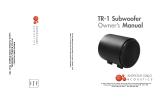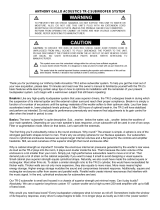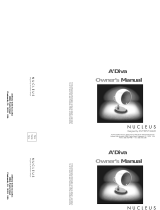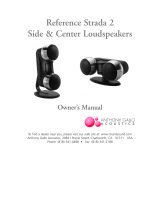Page is loading ...

ANTHONY GALLO
ACOUSTICS
MPS-150 Subwoofer
Owner’s Manual
To find a dealer near you, please visit our web site at: www.anthonygallo.co.uk
Anthony Gallo Acoustics, The Inox Building, Caldwellside, Lanark, United Kingdom ML11 7SR
Phone 0870 350 1348 • Fax 0870 350 1346
ANTHONY GALLO
ACOUSTICS
Anthony Gallo Acoustics
The Inox Building, Caldwellside,
Lanark, United Kingdom ML11 7SR
Place
Stamp
Here
Fill Out Warranty Information on back, detach and return
to us for your five year MPS-150 product warranty.
Sub Layout 4/10/02 9:15 AM Page 1

Name: MPS-150 Serial #
Address:
City: State: Zip:
Telephone: Email:
Where did you first hear about the MPS-150 Sub?
Magazine Web Dealer Other
How influential was your dealer in your decision to purchase the MPS-150?
Very Somewhat Not At All
What type of system did you purchase the MPS-150?
Stereo Home Theatre
What other Speakers did you listen to before choosing the MPS-150?
Excellent Very Good Good Fair Poor
Appearance
Build Quality
Size
Sound Quality
Ease of Set Up
Mounting Options
Match my decor
Owners Manual
Sub Layout 4/10/02 9:15 AM Page 2

Introduction
The Anthony Gallo Acoustics MPS-150 Nucleus Micro Subwoofer was designed to provide the highest
level of subwoofer performance in the smallest possible space. Your new subwoofer accomplishes two
seemingly contradictory goals. It combines linear frequency response and tremendous volume output with
a compact enclosure size. You will get more then enough output for even large rooms while still being
able to hide the sub under furniture. At the same time, the MPS-150 offers a wide assortment of control
options and an audiophile-quality power amplifier. In other words, this is a high quality sub capable of
sounding good with music and not just as a sound effects generator for theater sounds such as
explosions.
In order to achieve these goals, designer Anthony Gallo separated the acoustical and electrical functions
of the sub. The 10" custom made driver is housed in a 5.5" wide, 1 1" tall cylindrical enclosure, while all
controls, crossover electronics and 150 watt, class A/B amplifier are contained in a discrete chassis of
similar size. This arrangement offers the user unusual flexibility, enabling the electronics module to be
located either atop the woofer or near the rest of the Audio/Video System's components. The resulting
marriage of performance, size, features and flexibility is unique in the world of powered subwoofers. Other
subwoofers, once installed in wall for instance, offer no access to controls. They are set once and then
stay that way forever.
Sub Layout 4/10/02 9:15 AM Page 3

Description of Controls
Please note the diagram on the next page. The following controls are located at the rear of
the MPS-150’s electronic module.
1- LEVEL : Allows subwoofer output to be adjusted relative to the main speakers. Rotate knob
clockwise to increase subwoofer level, counterclockwise to decrease it.
2- CR
OSSO VER FREQ UENCY : Determines the highest frequency (in Hz) which will be reproduced
by the subwoofer. Used for tailoring MPS-150 to a wide variety of stereo speakers. Note: When using
MPS-150 with Nucleus Micro satellites. Crossover should be set at 120 Hz.
3- LINE IN / LINE OUT
: For connecting subwoofer to preamplifier or surround processor using RCA-
type ("line level") interconnects. This is the most common connection.
4- PO
WER: Three position toggle switch enables MPS-150 to be turned OFF (switch at far left
position) or ON (switch at far right position). When placed in AUTO (switch at central position), unit
turns on automatically when audio signal is present.
5- PHASE:
Allows user to choose normal- (0 degrees) or inverted- (180 degrees) subwoofer phase.
6- HI LEVEL IN / HI LEVEL OUT
:
For connecting subwoofer to receivers or integrated amplifiers
using speaker cables. To be used where Line Level outputs are not available, or where a"High Pass"
filter (i.e.? to prevent low frequencies from reaching stereo speakers) is needed.
7- A
C Line Cor d:
Supplies AC Power to Electronics Module.
8- Fuse:
Protects MPS-150 from abnormal power conditions.
9- l/4" Phone Jac
k:
Used for connecting Electronics Module to Woofer Module with supplied cable.
Warranty Information
You must fill out and return the warranty card to establish your ownership of our product, and retain the original dated bill of
sale. You will find a serial number on the subwoofer. Place that number on the warranty card when you return it.
Anthony Gallo Acoustics Limited Warranty
STATEMENT OF WARRANTY
We warranty this product to be free from all defects in material and workmanship for a period of five years. This warranty
extends to the original retail purchaser only, and not to subsequent purchasers or users of this product. Warranty is only vali d
in country of purchase.
This warranty will be void if:
l.Any defect in the product is the result of abuse, misuse, damage in transit, defective associated equipment, faulty
hook-up, the use of the speaker with equipment for which it was not intended or acts of God.
2.The serial number has been altered or removed.
3.The unit has been operated contrary to instructions contained in the accompanying Owner's Manual.
4.The unit has been serviced by unauthorized personnel.
All other warranties, express, implied or statutory, including but not limited to warranties of merchantability or fitness, and all
other obligations or liabilities of Anthony Gallo Acoustics are limited in time to the period of warranty granted hereby.
EXCLUSION OF CERTAIN DAMAGES
Anthony Gallo Acoustics liability is limited to the cost of repair or replacement, at our option, of any defective part or prod uct
and shall in no event include incidental or consequential damages of any kind.
The above provisions do not preclude the operation of an state statute which in certain circumstances may not allow some of
the limitations and exclusions described in this warranty.To obtain warranty service, please call the dealer from whom you
purchased your equipment.
WHAT WE WILL PAY FOR
We will pay all labor and material expenses for covered items, but you must pay any shipping charges if it
is necessary to ship the product to us or to an authorized Nucleus Micro dealer. If the repairs are covered by warranty, we wil l
pay the return shipping charges.
THIS WARRANTY GIVES YOU SPECIFIC LEGAL RIGHTS. YOU MAY ALSO HAVE OTHER RIGHTS WHICH MAY VARY FROM STATE TO STATE.
Copyright 2001, Anthony Gallo Acoustics. All rights reserved.
Sub Layout 4/10/02 9:15 AM Page 4

High Level Connections Continued
Using the MPS-150 with full frequency range speakers:
For systems where preventing bass signals from reaching your stereo speakers would be undesirable, connect TWO
SETS of speaker cables to the terminals of your receiver or amplifier. Run one set to the "HI LEVEL IN" terminals of
your MPS-150, and the second set directly to your stereo speakers. In this manner, you have by passed the MPS- l
50's "High Pass" crossover.
Connecting the Electronics and Subwoofer Modules
Using the cable supplied with your MPS-150, which terminates in a 1/4" phono plug at either end, install the plugs
into the corresponding jacks found on the Electronics and Subwoofer Modules.The right angle side attaches to the
sub. This cable allows the Electronics Module to supply power and signal to the Subwoofer Module. If a cable of
different length is needed, please contact your Authorized AGA Dealer.
Placement Of Your MPS-150
Given its small size and cylindrical shape, the sub module may easily be hidden from view. Finally a sub that
actually does fit under a piece of furniture. To obtain the best possible bass performance, however, please consider
the following placement rules.
Bass Output Varies With Placement.
Placing the MPS-150 near a wall (i.e., at the intersection of wall and floor) provides a doubling of output (+ 3dB)
compared with free space placement, while corner placement (the point where two adjacent walls and floor meet)
enables output to double again (+ 6 dB). In large or acoustically absorptive rooms, placing your MPS-150 near a
wall or corner might offer beneficial bass augmentation..
SIot-Loaded Woofer Design:
Your MPS-150 is a downward-firing or "slot-loaded" design whose output couples to the room through the narrow
space between the bottom of the woofer and the floor. Given the small size of this opening, it is important to keep
obstructions away from this space.
All Placements Are NOT Created Equal:
A subwoofer might sound noticeably different depending upon its location in the listening room. There will usually be
one spot at which any sub sounds its best. If possible, experiment with placement until the optimum position has
been determined.
Connecting your MPS-150
The following connection instructions will help you achieve the best subwoofer performance in your system.
Line Level Connections:
Connecting your MPS-150 to a home theater receiver .
In most cases you will be using these inputs. If you have a relatively new digital receiver it will have an "LFE" or
"subwoofer" output. Usually this is a single RCA type jack. Basically you will be running a cable that has RCA
connectors on both ends from this output on the receiver to the Line In jack on the sub. You can connect to either
right or left input on the sub with the same results.
Connecting your MPS-150 to a
preamplifier , stereo or Dolb y Pr o-Logic receiver .
Any component NOT equipped with a discrete "subwoofer output" jack or jacks: Essentially you will be using the
tape loop or pre-amp out jacks to send signal out of the receiver into the sub. Run interconnect from an output to
the LINE IN jacks on the sub's control panel. If necessary, run a line from the Line Out jacks back to the receiver.
WARNING:
LINE IN/ OUT jacks on the MPS-150 DO NOT include any crossover or signal filtering. When using
these connections in a system containing Nucleus Micro satellites or other bass-limited loudspeakers, you must
prevent low frequencies from reaching (and damaging) your satellites. Select the "small enclosure" option on your
surround processor or receiver's menu for each line running to a Micro or other limited low frequency (small)
satellite. If there is no such setting see High Level Connections to follow.
High Level Connections
High level inputs are used when the MPS-150 is included in a system where no line level (subwoofer) output
jacks are present. An entry-level receiver would be one example. (or where the inclusion of a "High Pass" filter is
necessary to prevent low frequencies from reaching the stereo speakers) In these cases the subwoofer must be
connected through the use of speaker cables. This will mostly be the case in 2 channel stereo applications.
Using the MPS-150 with Nucleus Micro or other small "satellite" speakers:
In cases where the lowest bass
frequencies would either damage the stereo speakers or inhibit sound quality, run speaker cable from the Main
(Front left and right) speaker terminals on the back of your amplifier or receiver to the "HI LEVEL IN" terminals on
the control panel of your sub's electronics module. Run a second set of cables from the MPS-150's "HI LEVEL
OUT"terminals to your stereo speakers.
Sub Layout 4/10/02 9:15 AM Page 5

Final Adjustments
Once your MPS-150 has been properly connected and positioned, performance can be further optimized by
adjusting the controls on the Electronic Module. For this purpose, it is helpful to use a recording of a deep male
voice.
Start by adjusting the LEVEL control. Increase subwoofer volume, or level, by rotating the control clockwise, until
the bass output is noticeably louder than the rest of the frequency range. Now, lower bass output by turning the
LEVEL control counterclockwise, until bass seems balanced with the rest of the audio frequencies, and sounds no
longer seem to emanate directly from the subwoofer. You will need to return to the listening position during
adjustments.
Next, crossover frequency must be precisely set. The CROSSOVER FREQUENCY control on your Electronics
Module determines the uppermost frequencies which will be reproduced by your MPS-150. Raise and lower the
crossover point by rotating the CROSSOVER FREQUENCY control clockwise and counter clockwise, respectively.
Too high a crossover frequency will cause male vocals to sound boomy and "chesty". Too low a point will render
the same vocals thin. Find a point at which voices sound natural. WITH NUCLEUS MICRO SATELLITES,
CROSSOVER FREQUENCY OF 120 HZ SHOULD BE IDEAL.
Note: Bass is non-directional; that is, low bass frequencies contain no left-or right-channel stereophonic
information. Therefore, it should be impossible to locate a properly set up subwoofer as a discrete source of
sound. However, when using a high crossover frequency (above approximately 100 Hz), your MPS-150 may
occasionally reproduce information with directional content. If this ever becomes highly noticeable, proper
integration between subwoofer and speakers can be restored by positioning the sub closer to the stereo speakers.
Finally, consider the PHASE switch. Experiment with both the 0-degree and 1 80-degree switch positions. The
correct setting is the one, which provides deeper bass and/or the most "seamless" integration between subwoofer
and speakers. After the proper phase has been determined, you can give the system a final "fine-tuning" by
readjusting LEVEL and CROSSOVER FREQUENCY controls if necessary.
Following these simple instructions and experimenting with placement and controls will enable you to enjoy the
best possible performance your MPS-150 is capable of providing. Thank you for taking the time to read the
manual, now lets get started!
Power Cord
Jumper to Sub
High Level In
High Level Out
Controls Diagram
Sub Layout 4/10/02 9:15 AM Page 6
/












